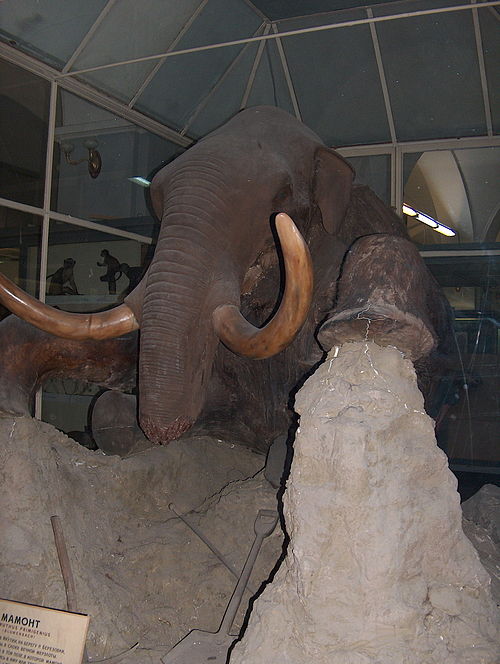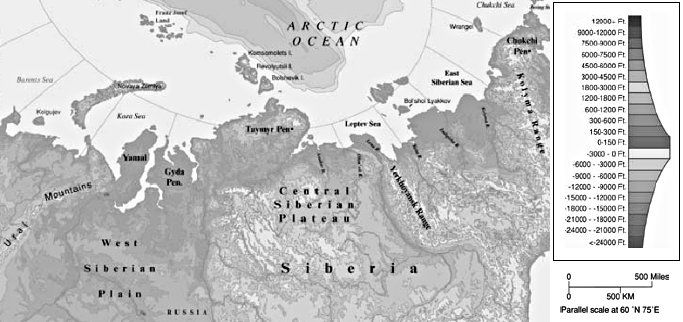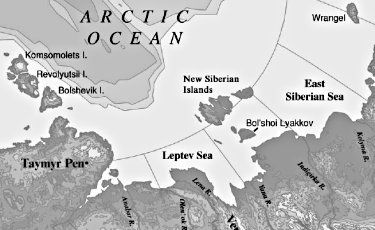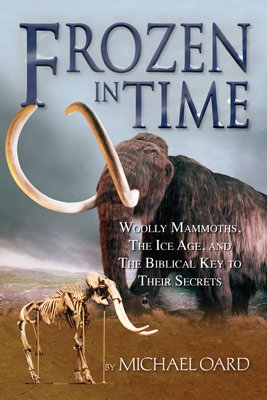
Chapter 1
Frozen Mammoth Carcasses in Siberia
Frozen mammoth carcasses found in Siberia have challenged our imagination for centuries. These carcasses sometimes come with skin, hair, and internal organs including the heart.1
Reports of these discoveries intrigue adults and children alike, for different reasons. One island in the New Siberian Islands, off the Arctic Ocean coast, is described as mostly mammoth bones. Over the years, a lucrative ivory trade developed as thousands of tons of ivory tusks have been unearthed and exported from Siberia. Scientists struggle to understand why these animals lived in Siberia and how they died. Children love stories of frozen carcasses with meat fresh enough to eat.

Figure 1.1
Many questions arise as a result of these strange discoveries. Why would the woolly mammoth, bison, woolly rhinoceros, and horse be attracted to Siberia? Today, Siberia is a barren, blizzard-scourged wilderness. How could the animals have endured the extremely cold winters? What would they eat? Where would the beasts locate the prodigious quantities of water they require when the land is imprisoned in snow and ice? Even the rivers are covered with several feet of ice every winter. Most puzzling of all is how did the mammoths and their companions die en masse and how could they have become encased in the permafrost?
Over time, various clues about the environment at the time of their death have been discovered and studied. Scientists found partially preserved stomach vegetation in some of the carcasses and so could identify the woolly mammoth’s last meal. Solving one mystery just leads to another. They wondered how the stomach contents remained half decayed while the animals froze? This is a problem since it takes a long time to freeze an animal as large as an elephant. A quick freeze came to mind. Birds Eye Frozen Foods Company ran the calculations and came up with a staggering -150°F (-100°C). Once again, the scientists were puzzled. How could such temperatures be reached on earth, especially when apparently they were in a fairly temperate environment before the quick freeze?
Many theories have been postulated. One of the most popular is that the hairy elephants were peacefully grazing on grass and buttercups and were suddenly struck by a huge freezing storm blowing from the Arctic Ocean. Millions of them froze instantly. This kind of quick freeze has never been observed, so some special and imaginative ideas have been proposed. One question seems to always lead to another. This story is based on the Beresovka mammoth that was excavated and shipped back to St. Petersburg, Russia, overland during a heroic expedition led by Otto Herz and E. Pfizenmayer. The expedition started in the late spring of 1901, and ended on February 18, 1902. To transport the mammoth flesh, they had to travel 3,700 miles (6,000 km) by sled during a bitterly cold Siberian fall and winter.2
We will explore these questions in this book and provide another theory based on the Ice Age. This Ice Age answers the questions about the migration and extinction of woolly mammoths and other animals in Siberia. The cause of the Ice Age still remains a mystery for mainstream scientists. So a theory for the Ice Age will be presented based on the Genesis flood as described in the Bible.
What exactly is a woolly mammoth?

Figure 1.2. The Beresovka mammoth on display in the Museum of Zoology in St. Petersburg. Image by Eino Mustonen via Wikimedia Commons.
A woolly mammoth (Mammuthus primigenius) is essentially a “hairy elephant” with a large shoulder hump, a sloping back, small ears and tail, unique teeth, and a small trunk with two finger-like projections at the tip. They usually have spirally curved tusks up to 11 feet (3.3 m) long. The world-record tusk is 13.5 feet (4.11 m) long and probably weighed around 225 pounds (about 100 kg).3 The woolly mammoth was covered with three types of hair: (1) the outer guard hairs that were coarse and just over 3 feet (90 cm) long, (2) an underfur that was thinner and about 10 to 12 inches (25 to 30 cm) long, and (3) below the underfur a thick layer of wool that was around 1 to 3 inches (2 to 8 cm) long.4 A full-grown mammoth tooth is over a foot long and has a series of parallel enamel ridges. The long hair, small ears, and tiny tail are probably adaptations to a cold climate.

Figure 1.3. The skull, jaw, and tusks of a woolly mammoth.
The woolly mammoth is one of two general types of mammoths in the genus Mammuthus. The Columbian mammoth is the second type. It is larger than the woolly mammoth, standing about 13 feet (4 m) high, compared to 9 to 11 feet (about 3 m) tall for the woolly mammoth.5 Both are members of the order Proboscidea in the biological classification system, which includes modern and extinct elephants. There are many disputes over the classification of elephants and mammoths (see appendix 1).
The woolly mammoth has some distinct adaptations to cold, such as thicker fur, than the Columbian mammoth. Did the woolly mammoth develop these adaptations because of the cold, or did the woolly mammoth always have such features and was more favorably disposed to migrate farther north? I would favor the former explanation, but there is no way to know for sure. The reason I favor adaptations to the cold is that such adaptations are built into the genes and chromosomes of many mammals and people today. We adapt to winter temperatures by physiological changes, such as the body producing thicker blood. These changes have nothing to do with evolution but are built into the organism. Certain genes that control other genes are triggered by environmental cues. So, I believe it is the same with the woolly mammoth. The cold likely triggered certain dormant genes that went into action and produced the long hair and other cold-adaptive traits.
Are there millions of mammoths buried in Siberia?
Many have claimed that there are millions of mammoths entombed in the permafrost of Siberia. Could this be true or is it a gross exaggeration? Farrand6 downsized the estimate to around 50,000 mammoths that died and are buried. It is very difficult to estimate the number of living animals in such a vast, poorly populated territory as Siberia, let alone the number of mammoths that might have died and been buried. Estimates have to be made on how many still lie hidden in the permafrost, which complicates the matter.7 Just how many mammoths were buried affects our theories on the environment of Siberia and their extinction.
When writing about the number of mammoth bones, tusks, and carcasses, researchers commonly emphasize the large number of bones that have been found. For instance, Valentina Ukraintseva8 states that the mammoths from Siberia were abundant, based on their numerous remains. Dale Guthrie,9 University of Alaska in Fairbanks, estimates that hundreds of thousands of mammal bones have been concentrated along streams in inland Alaska. Of course, a single animal has many bones, but Guthrie’s estimate does not include the bones not yet washed out of valley deposits or those that remain buried in the uplands. Irena Dubrovo10 remarks that there are a great number of woolly mammoth remains in Siberia. Explorers have always reported the remains as abundant.11

Figure 1.4. Map of Siberia and offshore in the Arctic Ocean, coded for elevation. Note that the northwest is a generally flat plain while there are mountain ranges in the south and east.
The top expert on woolly mammoths in Siberia is Nikolai Vereshchagin, who has spent nearly half a century researching the mammoth fauna. Since 1940, he has identified approximately a million bone fragments from many types of animals found within the permafrost of Eurasia.12 He states that the abundance of remains in Siberia is remarkable.13 There are many hundreds of thousands of large mammals buried in Siberia14 with many millions of bones.15
Erosion along the Arctic coast varies from 3 to 22 feet (1 to 7 m) a year,16 spilling an enormous number of woolly mammoth bones from the sea cliffs. In a report in the Smithsonian magazine, Stewart17 refers to an estimate made by Vereshchagin for a section along the Arctic coast between the Yana and Kolyma rivers:
Through such causes almost 50,000 mammoth tusks are said to have been found in Siberia between 1660 and 1915, serving an extensive mammoth ivory trade. But this is nothing compared to those still buried, according to Vereshchagin, who calculates that the heavy erosion of the Arctic coast spills thousands of tusks and tens of thousands of buried bones each year into the sea and that along the 600-mile coastal shallows between the Yana and Kolyma [rivers] lie more than half a million tons of mammoth tusks with another 150,000 tons in the bottom of the lakes of the coastal plain.
If each tusk weighs 100 pounds (45 kg), a reasonable estimate,18 Vereshchagin’s numbers would suggest that five million mammoths are buried in this region! Is he exaggerating? If he is, it probably isn’t by much. This area may well contain the highest density of mammoth remains, since the rich New Siberian Islands lie offshore. The coastal zone of the Laptev Sea, which includes the western area of Vereshchagin’s estimate, is regarded as one of the largest mammoth cemeteries in the world.19

Figure 1.5. North-central Siberia and the New Siberian Islands.
The number of woolly mammoths is more concentrated in northern Siberia.20,21 Mammoth remains are amazingly abundant on the Lyakhov Islands22 and on the other New Siberian Islands, 140 miles (230 km) north of the mainland.23,24 The early report of one of the New Siberian Islands being totally composed of bones is a gross exaggeration. The many bones found on these islands indicate that Siberia and the adjacent continental shelves with their islands was once a vast plain dotted with woolly mammoths and other animals. Vereshchagin and Kuz’mina25 state:
The shelf of the Laptev and East Siberian Seas [along the Arctic continental shelf] in some places … is covered with bones of horse, reindeer, bison, musk ox, and mammoth washed up by tidal waters. Occasionally, bones of wolf, brown bear, cave lion, and (rarely) woolly rhinoceros, moose, and saiga antelope are also found.
One can see that a wide diversity of animals accompanied the woolly mammoth in Siberia, as well as elsewhere across the Northern Hemisphere. This Ice Age environment has been called the mammoth steppe, which is a vast grassland.
Based on many reports, it appears that estimates of millions of woolly mammoths in the Siberian permafrost are correct. Lister and Bahn26 note that some scientists put the number at ten million mammoths in the Siberian deep freeze. This makes the question of how they could have possibly found enough food and water in such a cold area even more enigmatic.

Figure 1.6. Woolly mammoth carcass distribution in Northern Hemisphere. (Redrawn by Daniel Lewis with Eurasia.27)
Woolly mammoth fossils are not only commonly found in Siberia, but they are also found in unconsolidated sediments all across the mid- and high latitudes of the Northern Hemisphere. Sometimes their remains are dredged up from the continental shelves in some locations. Although associated with the Ice Age, they are rarely found in previously glaciated areas. They are mostly found in non-glaciated areas of Siberia. They spread from Siberia into the non-glaciated portions of Alaska and the Yukon by way of the Bering Land Bridge. This land bridge was dry or mostly dry during the Ice Age. From the Yukon, the mammoths migrated through western Alberta by way of the ice-free corridor and spread south throughout the northern United States. The Columbian mammoth is usually found farther south — in the southern United States, Mexico, and Central America.28,29 The number of woolly mammoth individuals fossilized worldwide probably exceeds 15 million.
Carcass puzzles
As if the existence of frozen carcasses isn’t mysterious enough, several aspects of the carcasses are very puzzling.
A number of carcasses, as well as a few skeletons, have been discovered in a general standing position. It looks like the animal sank in a bog, but generally Siberian bogs are not deep enough to bury an animal that size. Also, the majority of the sediment surrounding the carcasses is not bog sediment.30 Henry Howorth31 tells us:
The same conclusion was arrived at by Brandt, from a consideration of the fact that the bodies and skeletons of Mammoths are sometimes found standing upright, as if they had sunk in that position into the soft ground. This was the case with the specimen found by Ssarytschef, near Alansk … with a skeleton found about 1827 near Petersburgh, as reported to Brandt by Pander; a third which was found in the peninsula of the Obi, fifty versts from the mouth of the Yerambei; and a fourth found in the government of Moscow, all of which are discussed by Brandt … .
The Beresovka mammoth was found in a sitting position, although it had slumped down the slope probably in a frozen block before discovery.32 The unique position of this mammoth indicates that the sliding probably did not change the original position of the mammoth at death. Even the trees were still generally upright in the material that slid down the hill.33
Russian researcher Tolmachoff reported several upright mammoth carcasses in Siberia. One of the carcasses was found in 1839, on the Shangin River, a tributary to the Indigirka River, in an upright position and protruding from a cliff.34 Another upright mammoth was also discovered in a cliff on the New Siberian Islands.35 Tolmachoff36 himself found parts of the skeleton of a mammoth on the coast of the Arctic Ocean, “… protruding out of frozen bluff in a more or less upright position.” He mentions in words similar to Howorth’s how Brandt was impressed about these upright mammoths:
Brandt was very much impressed by the fact that remnants of the mammoth, carcasses and skeletons alike, sometimes were found in poses which indicated that the animals had perished standing upright, as though they had bogged.37
Strangely, scientists investigating three woolly mammoths and two woolly rhinos, including the Beresovka mammoth, found they all died by suffocation.38 For a live animal to die of suffocation, it had to be buried rapidly or drowned.
Several of the carcasses have broken bones. Both of the upper front leg bones and some of the ribs of the Selerikan horse were broken.39 It was also missing its head. The Beresovka mammoth had a broken pelvis, ribs, and right foreleg.40 It takes quite a force to break the bones of a mammoth. The broken bones have inspired the story that the Beresovka mammoth was grazing on grass and buttercups when it accidentally fell into a crevasse in the permafrost. Then it was rapidly covered and suffocated.41 Buttercups, as well as leaves and grasses, were found in the mouth of the Beresovka mammoth between its teeth and tongue.42
Not only is it difficult to explain the upright burial, but even more challenging is the question of how these many mammoths and other animals ended up inside the permafrost layer. Both carcasses and bones had to be buried quickly, below the summer melt layer of the permafrost, before they rotted. Howorth43 states the problem this way:
Now, by no physical process known to us can we understand how soft flesh could thus be buried in ground while it is frozen as hard as flint without disintegrating it. We cannot push an elephant’s body into a mass of solid ice or hard frozen gravel and clay without entirely destroying the fine articulations and pounding the whole mass into a jelly, nor would we fail in greatly disturbing the ground in the process.
Table 1.1. Mammoth carcass puzzles
- Some carcasses and skeletons were found in a general, standing position
- Three woolly mammoths and two woolly rhinos suffocated
- Millions of animals became entombed in rock-hard permafrost
- Some of the mammals have broken bones
This is not just Howorth’s opinion. Quackenbush44 reinforces his assessment:
But, if flesh was preserved only when protected from air, bodies found entire must have been rapidly and completely covered, and it is not evident how this could have occurred otherwise than by their sinking into some kind of soft or boggy ground.
Any plausible theory explaining why woolly mammoths inhabited Siberia and how they died must also be able to explain these carcass puzzles, which are shown in table 1.1.
Frozen in Time
Author Michael Oard gives plausible explanations of the seemingly unsolvable mysteries about the Ice Age and the woolly mammoths.
Read Online Buy BookFootnotes
- Agenbroad, L.D. and L. Nelson, Mammoths: Ice Age giants, Lerner Publications Company, Minneapolis, MN, p. 8, 2002.
- Pfizenmayer, E.W., Siberian man and mammoth, Blackie & Sons, London, 1939.
- Agenbroad & Nelson, Mammoths: Ice Age giants, p. 33.
- Agenbroad & Nelson, Mammoths: Ice Age giants, p. 42–43.
- Agenbroad & Nelson, Mammoths: Ice Age giants, p. 40.
- Farrand, W.R., Frozen mammoths and modern geology, Science 133:729–735, 1961.
- Ukraintseva, V.V., Vegetation cover and environment of the “Mammoth Epoch” in Siberia, Mammoth Site of Hot Springs, South Dakota, Inc., Hot Springs, SD, p. 234, 1993.
- Ukraintseva, V.V., Vegetation cover and environment, p. 224
- Guthrie, R.D., Frozen fauna of the mammoth steppe — The story of Blue Babe, University of Chicago Press, Chicago, IL, p. 67, 1990.
- Dubrovo, I., The Pleistocene elephants of Siberia; in: Megafauna and man — Discovery of America’s heartland, The Mammoth Site of Hot Springs, South Dakota, Inc., Hot Springs, SD, scientific papers, volume 1, p. 3, 1990.
- Péwé, T.L., and D.M. Hopkins, Mammal remains of pre-Wisconsin age in Alaska; in: The Bering land bridge, D.M. Hopkins (Ed.), Stanford University Press, Stanford, CA, p. 266, 1967.
- Vereshchagin, N.K., An experiment in the interpretation (visual assessment) of mammalian bones from sediments of the Quaternary Period; in: Late Quaternary environments and deep history: A tribute to Paul S. Martin, D.W. Steadman and J.I. Mead (Eds.), The Mammoth Site of Hot Springs, South Dakota, Inc., Hot Springs, SD, p. 61, 1995.
- Vereshchagin, N.K., and G.F. Baryshnikov, Paleoecology of the mammoth fauna in the Eurasian Arctic; in: Paleoecology of Beringia, D.M. Hopkins, J.V. Matthews Jr., C.E. Schweger, and S.B. Young (Eds.), New York: Academic Press, p. 267, 1982.
- Vereshchagin, N.K., The mammoth “cemeteries” of north-east Siberia, Polar Record 17(106), p. 3, 1974.
- Vereshchagin, N.K., Experiment in the interpretation, p. 62.
- Thiede, J., H. Kassens, and L. Timokhov, Laptev Sea system discussed at Russian-German workshop, EOS 81(32):361, 366–367, 2000.
- Stewart, J.M., Frozen mammoths from Siberia bring the ice ages to vivid life, Smithsonian 8, p. 68, 1977.
- Agenbroad & Nelson, Mammoths: Ice Age giants, p. 33.
- Thiede, Laptev Sea system, p. 367.
- Howorth, H.H., The mammoths in Siberia, Geological Magazine 7:550–561, 1880.
- Digby, B., The mammoth and mammoth-hunting in north-east Siberia, H.F. & G. Witherby, London, p. 14, 1926.
- Baryshnikov, G., G. Haynes, and J. Klimowicz, Mammoths and the mammoth fauna: Introduction to the studies of an extinct ecosystem; in: Mammoths and the mammoth fauna: Studies of an extinct ecosystem, G. Haynes, J. Klimowicz, and J.W.F. Reumer (Eds.), Proceedings of the First International Mammoth Conference, Jaarbericht Van Het Natuurmuseum, Rotterdam, p. 5, 1999.
- Howorth, H.H., The mammoths in Siberia, Geological Magazine 7:550–561, 1880.
- Nordenskiöld, A.E., The voyage of the Vega round Asia and Europe, MacMillan and Co., London, p. 149, 155, 1883.
- Vereshchagin, N.K., and I.Y. Kuz’mina, I, Late Pleistocene mammal fauna of Siberia; in: Late Quaternary environments of the Soviet Union, A.A. Velichko (Ed.), University of Minnesota Press, Minneapolis, MN, p. 219, 1984.
- Lister, A., and P. Bahn, Mammoths, Macmillan, New York, p. 115, 1994.
- From Kahlke, R.D., The history of the origin, evolution and dispersal of the Late Pleistocene Mammuthus-Coelodonta faunal complex in Eurasia (large mammals), Mammoth Site of Hot Springs South Dakota, Inc., Hot Springs, SD, 1999; figure 13.
- Fagen, B.M., The great journey — The peopling of ancient America, Thames and Hudson, London, 1987.
- Siebe, C., P. Schaaf, and J. Urrutia-Fucugauchi, Mammoth bones embedded in a late Pleistocene lahar from Popocatépetl volcano, near Tocuila, central Mexico, Geological Society of America Bulletin 111:1550–1562, 1999.
- Howorth, H.H., The Mammoth and the flood — An attempt to confront the theory of uniformity with the facts of recent geology, Sampson Low, Marston, Searle, & Rivington, London (reproduced by The Sourcebook Project, Glen Arm, Maryland), p. 61, 185, 1887.
Pfizenmayer, Siberian man and mammoth, p. 7 - Howorth, H.H., The mammoths in Siberia, Geological Magazine 7, p. 551–552, 1880.
- Pfizenmayer, Siberian man and mammoth, p. 86.
- Guthrie, Frozen fauna, p. 7.
- Tolmachoff, I.P., The carcasses of the mammoth and rhinoceros found in the frozen ground of Siberia, Transactions of the American Philosophical Society 23, p. 26, 1929.
- Tolmachoff, Carcasses of the mammoth, p. 32.
- Tolmachoff, Carcasses of the mammoth, p. 36.
- Tolmachoff, Carcasses of the mammoth, p. 56.
- Digby, B., The mammoth and mammoth-hunting in north-east Siberia, H.F. & G. Witherby, London, p. 54, 1926.
Tolmachoff, Carcasses of the mammoth.
Farrand, W.R., Frozen mammoths and modern geology, p. 734. - Guthrie, R.D., Frozen fauna of the mammoth steppe — The story of Blue Babe, University of Chicago Press, Chicago, IL, p. 31, 1990.
- Digby, B., The mammoth and mammoth-hunting in north-east Siberia, H.F. & G. Witherby, London, 1926.
Pfizenmayer, E.W., Siberian man and mammoth, Blackie & Sons, London, 1939. - Pfizenmayer, Siberian man and mammoth, p. 90.
- Pfizenmayer, Siberian man and mammoth, p. 39.
Guthrie, R.D., Frozen fauna, p. 4. - Howorth, H.H., The Mammoth and the flood — An attempt to confront the theory of uniformity with the facts of recent geology, Sampson Low, Marston, Searle, & Rivington, London (reproduced by The Sourcebook Project, Glen Arm, Maryland), p. 95, 1887.
- Quackenbush, L.S., Notes on Alaskan mammoth expedition of 1907 and 1908, Bulletin of the American Museum of Natural History 25:87–130, 1909.

Answers in Genesis is an apologetics ministry, dedicated to helping Christians defend their faith and proclaim the good news of Jesus Christ.
- Customer Service 800.778.3390
- Available Monday–Friday | 9 AM–5 PM ET
- © 2026 Answers in Genesis

